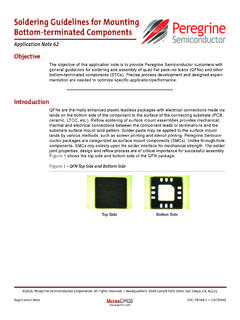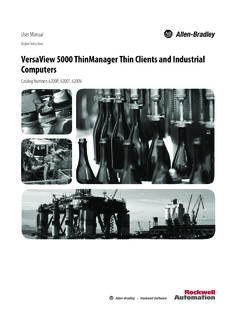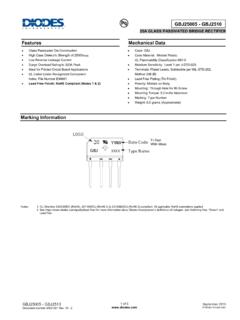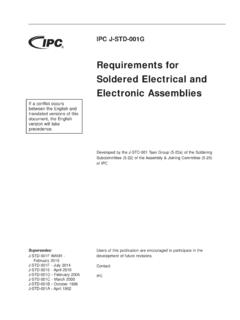Transcription of PCB Design Guidelines For Reduced EMI - Texas Instruments
1 PCB Design Guidelines For Reduced EMI. SZZA009. November 1999. 1. IMPORTANT NOTICE. Texas Instruments and its subsidiaries (TI) reserve the right to make changes to their products or to discontinue any product or service without notice, and advise customers to obtain the latest version of relevant information to verify, before placing orders, that information being relied on is current and complete. All products are sold subject to the terms and conditions of sale supplied at the time of order acknowledgement, including those pertaining to warranty, patent infringement, and limitation of liability.
2 TI warrants performance of its semiconductor products to the specifications applicable at the time of sale in accordance with TI's standard warranty. Testing and other quality control techniques are utilized to the extent TI deems necessary to support this warranty. Specific testing of all parameters of each device is not necessarily performed, except those mandated by government requirements. CERTAIN APPLICATIONS USING SEMICONDUCTOR PRODUCTS MAY INVOLVE. POTENTIAL RISKS OF DEATH, PERSONAL INJURY, OR SEVERE PROPERTY OR. ENVIRONMENTAL DAMAGE ( CRITICAL APPLICATIONS ).
3 TI SEMICONDUCTOR. PRODUCTS ARE NOT DESIGNED, AUTHORIZED, OR WARRANTED TO BE SUITABLE FOR. USE IN LIFE-SUPPORT DEVICES OR SYSTEMS OR OTHER CRITICAL APPLICATIONS. INCLUSION OF TI PRODUCTS IN SUCH APPLICATIONS IS UNDERSTOOD TO BE FULLY. AT THE CUSTOMER'S RISK. In order to minimize risks associated with the customer's applications, adequate Design and operating safeguards must be provided by the customer to minimize inherent or procedural hazards. TI assumes no liability for applications assistance or customer product Design . TI does not warrant or represent that any license, either express or implied, is granted under any patent right, copyright, mask work right, or other intellectual property right of TI covering or relating to any combination, machine, or process in which such semiconductor products or services might be or are used.
4 TI's publication of information regarding any third party's products or services does not constitute TI's approval, warranty or endorsement thereof. Copyright 1999, Texas Instruments Incorporated 2. Contents Title Page ABSTRACT .. 1. 1 Background .. 1. RF Sources .. 1. Surface-Mount Devices vs Through-Hole Components .. 1. Static Pins vs Active Pins vs Inputs .. 1. Basic Loops .. 2. Proportionality of Loops and Dipoles .. 3. Differential vs Common Mode .. 3. 2 board Layout .. 4. Grounds and Power .. 4. Inductance .. 4. Two-Layer vs Four-Layer Boards.
5 4. Microcomputer Grounds in One- and Two-Layer Designs .. 5. Signal Return Grounds .. 5. Analog vs Digital vs High Power .. 5. Analog Power-Supply Pins and Analog Reference Voltages .. 6. Power Plane Do's and Dont's for Four-Layer Boards .. 6. Power Distribution for Two-Layer Boards .. 7. Single-Point vs Multipoint Distribution .. 7. Star Distribution .. 7. Gridding to Create Planes .. 7. Bypassing and Ferrite Beads .. 9. Keeping Noise Close to the Chip .. 11. board Zoning .. 12. Signal Traces .. 13. Capacitive and Inductive Crosstalk.
6 13. Antenna Factor Length Rules .. 13. Series Termination, Transmission Lines .. 13. Impedance Matching at Inputs .. 14. Cables and Connectors .. 14. Differential-Mode and Common-Mode Noise .. 14. Crosstalk Model .. 14. Number of Returns .. 15. I/O Recommendations for Off-PCB Signals .. 15. Keeping Noise and Electrostatic Discharge (ESD) Out .. 15. Other Layout Issues .. 15. Front-Panel PCB with Keypad and Display in Automotive and Consumer Applications .. 15. Layout for Susceptibility .. 16. Autorouters .. 16. 3 Shielding.
7 17. How It Works .. 17. Grounding the Shield .. 17. Cables and Bypassing to the Shield .. 17. Slot Antennas: Cooling Slots and Seams .. 18. 4 Summary .. 18. 5 Literature .. 19. iii List of Illustrations Figure Title Page 1 Signals Below 50 kHz Are Not EMI Concerns .. 2. 2 Examples of Loops .. 3. 3 Differential vs Common-Mode Noise .. 4. 4 Microcomputer Ground .. 5. 5 Layout Considerations .. 6. 6 Power Distribution .. 7. 7 Gridding Power Traces on Two-Layer Boards .. 8. 8 Gridding of Ground Fills and Traces to Form a Ground Plane.
8 9. 9 Ferrite-Bead Placement Closest to the Noise Source .. 10. 10 board Zoning .. 12. 11 MOS Buffer Simplified Schematic .. 14. 12 Front-Panel Gridding to Form Two Ground Planes .. 16. 13 Mounting Filter Capacitors for External I/Os .. 18. List of Tables Table Title Page 1 Termination Characteristics .. 13. iv ABSTRACT. General layout Guidelines for printed circuit boards (PCB), which exist in relatively obscure documents, are summarized. Some Guidelines apply specifically to microcontrollers; however, the Guidelines are intended to be general, and apply to virtually all modern CMOS integrated circuits.
9 This document covers most known and published layout techniques as applied in a low-noise, unshielded environment. Efforts have been made to target two-layer boards, and the maximum acceptable noise level is assumed to be 30 dB, or greater, more stringent than FCC Part 15. This level seems to be the upper limit of acceptable noise in European and automotive markets. This document does not always explain the why's of a given technique because it is intended only as a reference document, not a teaching aid. The reader is cautioned against making the assumption that although on a prior Design a given technique was not applied and the unit had acceptable performance, that the technique is not useful.
10 Over time, as IC devices increase in speed and density, every method to isolate and reduce noise will be required. 1 Background RF Sources Design Guidelines to be discussed concern radio-frequency (RF) noise from the microcomputer. This noise is generated inside the device and is coupled out in many different possible ways. The noise is present on all outputs, inputs, power supply, and ground at all times. Potentially, every pin on the microcomputer can be a problem. The biggest problem is noise from the integrated-circuit (IC) input/output (I/O) pins.
















